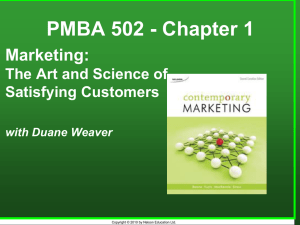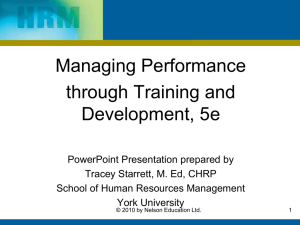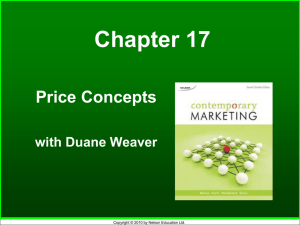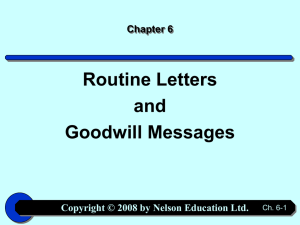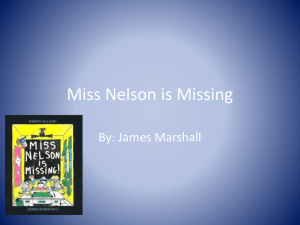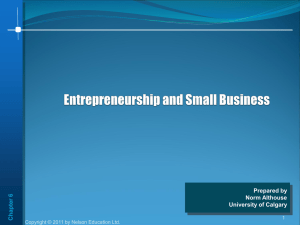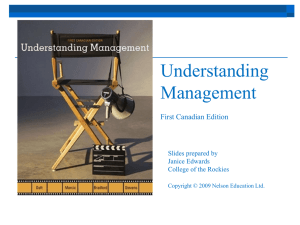- Computing in the Humanities and Social Sciences
advertisement
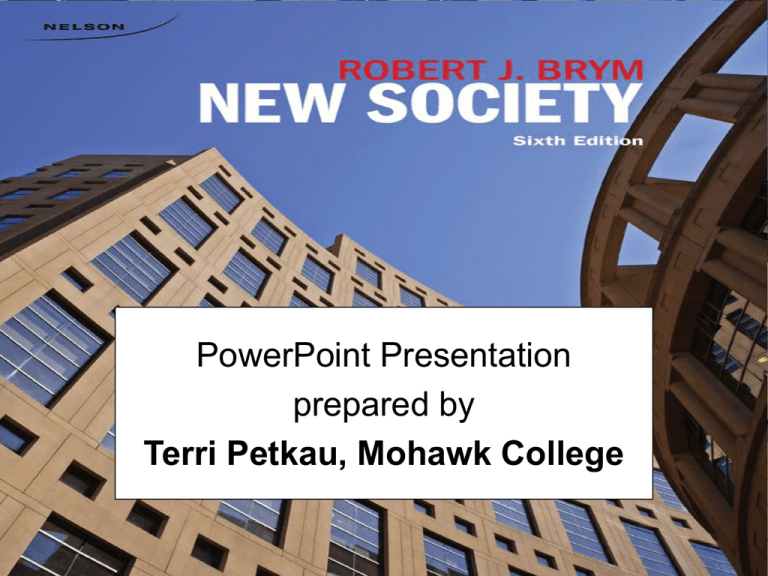
PowerPoint Presentation prepared by Terri Petkau, Mohawk College CHAPTER FIVE The Mass Media Josh Greenberg Graham Knight INTRODUCTION • Will examine: The mass media and interactive media Theoretical approaches in media studies Political economy of the media Copyright © 2011 by Nelson Education Ltd Role of television in the economy, culture, and identity News and ideology Research on media effects Forms of computer-mediated communication* 5-3 COMMUNICATION • Communication: To bring together or unify by establishing shared meanings and understandings between groups and individuals* Copyright © 2011 by Nelson Education Ltd 5-4 THE MASS MEDIA AND INTERACTIVE MEDIA • Mass media: Technologically-mediated means of communication in which flow of messages is largely unidirectional from a single point of transmission to a large, anonymous, dispersed audience of receivers (e.g., television) Copyright © 2011 by Nelson Education Ltd • Interactive media: Communications flow back and forth; people exchange roles with one another in the transmission and reception of communication (e.g., social networking websites)* 5-5 THEORETICAL APPROACHES IN MEDIA STUDIES Copyright © 2011 by Nelson Education Ltd 1. The technological perspective: Derives primarily from the work of (i) Innis and (ii) McLuhan i. Innis Made distinction between two types of media: a) Time-based media b) Space-based media Each type fosters different social perceptions, interactions, and institutional arrangements…* 5-6 1. TECHNOLOGICAL PERSPECTIVE: i. INNIS a) Time-based media: Copyright © 2011 by Nelson Education Ltd • Modes of communication that endure over time but are not very mobile across space (e.g. writing on stone or clay tablets) • Are conducive to strong sense of tradition and custom • Promote religious forms of power and belief* 5-7 1. TECHNOLOGICAL PERSPECTIVE: i. INNIS b) Space-based media: Modes of communication that can cover greater areas of space but are much less durable over time (e.g., writing on paper; sounds transmitted over airwaves) • Lead to territorial expansion, empire building, and more secular forms of power and culture Copyright © 2011 by Nelson Education Ltd • Different forms of power create different types of social division and conflict: Struggle against elite control by those excluded from power has resulted in shift from time- to space-based media* 5-8 1. TECHNOLOGICAL PERSPECTIVE: ii. MCLUHAN Copyright © 2011 by Nelson Education Ltd • Argued influence of mass media on society is mediated by the way the media change people’s sense perceptions and cognitive processes Example Invention of printing, which… i. Undermined oral communication by establishing more visual culture where words are linked in a linear way ii. Promoted interpreting the world in linear, cause-and-effect way…* 5-9 1. TECHNOLOGICAL PERSPECTIVE: ii. MCLUHAN Invention of printing, which… (continued) iii. Moved communication away from face-to-face interaction, making information more abstract Copyright © 2011 by Nelson Education Ltd iv. Fostered individualism, privacy, rationality, and social differentiation (through abstracting effect) v. Encouraged view of world as composed of separate objects vi. Enabled standardizing of national languages* 5-10 1. TECHNOLOGICAL PERSPECTIVE: ii. MCLUHAN • Effects of innovation of television: i. Allows for instantaneous communication ii. Helps viewers achieve better sensory balance Unlike print, does not rely solely on one sense Copyright © 2011 by Nelson Education Ltd iii. Is more socially inclusive than print iv. Ushered in new era of global democracy in “global village”* 5-11 1. TECHNOLOGICAL PERSPECTIVE: ii. MCLUHAN • Theory largely dismissed as technological determinism: Copyright © 2011 by Nelson Education Ltd Social change is determined by nature and function of technology, not by conscious human action* 5-12 2. THE CRITICAL PERSPECTIVE • Holds that (i) institutions (such as the news media) and (ii) processes (such as socialization and social control) cannot be understood from viewpoint of society as a whole Copyright © 2011 by Nelson Education Ltd Rather, need to be understood from that of unequal and conflicting groups and classes…* 5-13 2. THE CRITICAL PERSPECTIVE Copyright © 2011 by Nelson Education Ltd • Capitalist class and other powerful groups reinforce their position and maintain status quo through: i. Control over dominant ideology (interests, perspectives, viewpoints, and understandings of dominant class and other powerful groups) ii. Establishment of hegemony (dominant class using media to naturalize and universalize dominant ideology and absorb challenge of alternative and oppositional viewpoints)…* 5-14 2. CRITICAL PERSPECTIVE: FIRST VARIANT Copyright © 2011 by Nelson Education Ltd i. Control over dominant ideology • Initially developed by Horkheimer and Adorno: Viewed media as part of broader “culture industry” that functions to create “mass deception” about exploitative and oppressive character of capitalist society • “Propaganda model” of Herman and Chomsky: Suggested that media “filters” information to reduce or eliminate radical or subversive views…* 5-15 HERMAN AND CHOMSKY: FILTERS Copyright © 2011 by Nelson Education Ltd • a) Five main filters used by media: Orientation to profit-making b) Dependency on advertising for revenue and profit c) Reliance on powerful institutions and individuals as sources of information d) Negative reaction (“flak”) if media deviate from promoting elite interests and values e) Adherence to anti-communism as overarching belief system (anti-communism since replaced by “war on terrorism;” e.g., Iraq war)* 5-16 2. CRITICAL PERSPECTIVE: SECOND VARIANT Copyright © 2011 by Nelson Education Ltd ii. Establishment of hegemony • Dominant groups control both resistance and struggle (which arise from inequality) by accommodating and incorporating range of different viewpoints, including: Oppositional viewpoints: Represent experiences of subordinated groups against those of the powerful Alternative viewpoints: Blend of elements of dominant and oppositional viewpoints* 5-17 THE POLITICAL ECONOMY OF THE MEDIA • Focuses on: Ownership and control of economic resources, and Effect of technology and economic power on cultural values, social structure, and political decision making Copyright © 2011 by Nelson Education Ltd • Notes increasing concentration of ownership and control of media (e.g., multimedia chains, such as Disney) Enhanced by development of digital technologies* 5-18 THE WALT DISNEY COMPANY Copyright © 2011 by Nelson Education Ltd 5-19 THE POLITICAL ECONOMY OF THE MEDIA: MUTIMEDIA CHAINS • Multimedia chains practice both: Horizontal consolidation: Sharing of facilities and resources between different plants and outlets Copyright © 2011 by Nelson Education Ltd Vertical integration: Controlling of resources and assets at different stages of production Example: Ownership of major league sports team along with stations and cable channels on which games televised* 5-20 GLOBAL ENTERTAINMENT MEDIA CORPORATIONS Copyright © 2011 by Nelson Education Ltd 5-21 NEWSPAPERS: CONCENTRATION, MONOPOLY, AND ADVERTISING • Copyright © 2011 by Nelson Education Ltd The critical perspective argues homogenization of news coverage and decline in diversity in news topics and viewpoints are result of: Multimedia chain ownership (e.g., Bell Globemedia) Advertising dependency Local newspaper monopolies But research evidence supporting link is inconclusive* 5-22 TELEVISION: ECONOMY, CULTURE, AND IDENTITY • Greatest impact on content and role of television: Commercialization and advertising Copyright © 2011 by Nelson Education Ltd • Canadian television largely dominated by American television industry Domination derided by critical theorists as cultural imperialism When one society’s media exert overwhelming and unilateral influence over another society’s culture* 5-23 Copyright © 2011 by Nelson Education Ltd PERCENTAGE VIEWING TELEVISION 15 OR MORE HOURS PER WEEK, CANADA, 2007 5-24 VALUE OF INTERNATIONAL TRADE IN CULTURAL GOODS, CANADA, 2007 (THOUSANDS OF DOLLARS) Copyright © 2011 by Nelson Education Ltd 5-25 TELEVISION: ECONOMY, CULTURE, AND IDENTITY Copyright © 2011 by Nelson Education Ltd • Critics of cultural nationalist position argue that although dramatic television is important, Canadians also develop sense of collective national identity through their overwhelming preferences for domestic news and public affairs programming Example: Despite consumption of American programming, Canadians overwhelmingly prefer to get their news and public affairs information from the CBC and CTV rather than Fox or CBS* 5-26 TELEVISION: ECONOMY, CULTURE, AND IDENTITY Copyright © 2011 by Nelson Education Ltd • Concern that Canadian culture is under siege by American-style programming also ignores fact that many high-profile faces in American mass media are originally Canadian • Might also question supposed Americanization of Canadian identity through the mass media by noting Canada is quickly becoming a “postnational” society* 5-27 REPRESENTATION AND IDEOLOGY: THE MEANING OF THE MESSAGE • Media communicate messages on different levels: the pleasurable, the meaningful, the entertaining, and the informative Copyright © 2011 by Nelson Education Ltd • Communication entails process of representation: Use of language, visual images, and other symbolic tools to portray something in a coherent meaningful way that others can understand • Sociologists use term, framing, to denote selective, organized nature of representation that has ideological effects* 5-28 NEWS AND IDEOLOGY Copyright © 2011 by Nelson Education Ltd • News media: One of principle sources of information about social reality • Conservative and critical writers disagree about which of following two positions apply: i. News media as supporting “left-liberal” bias that runs counter to views and interests of society’s mainstream (endorsed by conservative perspective) ii. News media as representative of dominant ideology given concentrated ownership and hierarchy of access (endorsed by critical perspective)* 5-29 DEFINING THE NEWS Copyright © 2011 by Nelson Education Ltd • News values: Criteria used by news media to define and represent events and issues • i. Criteria include: Immediacy (can write stories in present tense) ii. Personalization (can reduce causes and explanations to level of individual motives and psychology) iii. Extraordinariness (events and issues entail conflict, confrontation, deviance, or disorder)* 5-30 NEWS AND DOMINANT IDEOLOGY • While news dwells on the negative, it still reinforces dominant ideology by: Reinforcing dominant definitions of what is normal and desirable, and Copyright © 2011 by Nelson Education Ltd Focusing on actions of appropriate social control authorities* 5-31 GATHERING THE NEWS Copyright © 2011 by Nelson Education Ltd • In preparing new stories, the mass media rely on: i. Official news sources: Representatives of dominant institutions used by media to define basic meaning of issue or event (e.g., politicians, police officers, professionals, experts) ii. Ordinary news sources: Sources without a group affiliation (e.g., victims or eye witnesses) iii. Alternative news sources: Representatives of social movements and social advocacy/activism groups, whose viewpoints often diverge from those of dominant social groups* 5-32 TORONTO “DAYS OF ACTION” HEADLINES Copyright © 2011 by Nelson Education Ltd 5-33 MEDIA EFFECTS AND AUDIENCES • Are two approaches to study of media effects: Copyright © 2011 by Nelson Education Ltd 1. Study of effects of media violence: Concerns about effects of media violence overshadow concerns about its causes 2. Audience interpretation: Examines the way viewers make sense of what they see and hear on television* 5-34 MEDIA VIOLENCE • Two main approaches in current media research: Copyright © 2011 by Nelson Education Ltd 1. Cultivation analysis: Examines effect of media violence on attitudes Gerbner: Argues long-term exposure gives rise to “‘mean world’ syndrome” 2. Focus on effects of television on behaviour Predominant view: Media violence has some real-life effects* 5-35 MEDIA VIOLENCE • • Copyright © 2011 by Nelson Education Ltd Evidence inconclusive on alleged causal relationship between media violence and violent behaviour Laboratory experiments purporting to demonstrate relationship are criticized on grounds of artificiality Alternate explanation: Social learning theory, that suggests media violence provides scripts that teach children how and when to act aggressively However, relationship between TV and real violence is bidirectional Watching violent TV fosters aggressiveness, but those who prefer to watch violent TV already have more aggressive tendencies* 5-36 AUDIENCE RESEARCH: INTERPRETATION AND MEDIA USE • Television has been primary focus of audience research because since WWII it has played central role in definition of private sphere in modern society (i.e., family, domesticity, gender relations, consumption, and suburban living) Copyright © 2011 by Nelson Education Ltd • Research tradition argues people are not passive recipients of message: Rather, people often filter, interpret, and even challenge messages they see and hear based on their social context, experiences, and beliefs* 5-37 AUDIENCE RESEARCH: INTERPRETATION AND MEDIA USE • TV has spread to other social settings, such as bars, malls, classrooms, and sports stadiums • TV has also become more dispersed within the household allowing more autonomy and privacy in viewing habits Copyright © 2011 by Nelson Education Ltd • Personalized watching has also been encouraged by proliferation of specialty channels and services catering to particular tastes and interests…* 5-38 AUDIENCE RESEARCH: INTERPRETATION AND MEDIA USE Copyright © 2011 by Nelson Education Ltd • New interactive technologies have become more accessible, creating a more complex communications environment that mediates the role and tempers the impact that any single medium can have at home, work, or school • These changes have shifted the focus of audience research toward the ways television fits into the broader media culture* 5-39 THE INTERNET: COMPUTER-MEDIATED COMMUNICATION • Forms of computer-mediated communication (CMC): E-mail, instant messaging (IM), blogs and chat rooms, video-sharing sites (e.g., YouTube) and social networking applications (e.g., Facebook and MySpace) Copyright © 2011 by Nelson Education Ltd • Constantly-changing nature of Internet (both technologically and socially) and research on its structure, use, and effects have produced divergent findings and interpretations that compound its uncertainty* 5-40 THE INTERNET: COMPUTER-MEDIATED COMMUNICATION Copyright © 2011 by Nelson Education Ltd • Macrolevel research has focused not only on inequalities in terms of Internet access, usage, and scope, but also on the ways in which new media technologies challenge our understanding of what CMC means • Microlevel research has been concerned with the reciprocal effects between offline and online interaction* 5-41 THE DIGITAL DIVIDE: CMC AND SOCIAL INEQUALITY • Digital divide: Term used to explain how access to and use of CMC reproduce structural inequities Copyright © 2011 by Nelson Education Ltd • Has been rapid Internet growth since early 1990s, but still considerable inequality in access and use • Social class, occupation, and education tend to be strong predictors of usage • Access related to race and ethnicity more in USA than in Canada* 5-42 THE INTERNET: DIFFERENCES OF USE • E-mail still most commonly used form of CMC among Canadians although overall use becoming more varied (e.g., for educational, financial, and consumption purposes, in particular) • Like access, use varies by social status and identity Copyright © 2011 by Nelson Education Ltd • Some research finds women more likely than men to have accounts on social networking sites • Differences in usage indicate different desires and needs of audience segments and their need for culturally-specific content* 5-43 CANADIAN INTERNET USE AT HOME BY INTERNET ACTIVITY, 2007 Copyright © 2011 by Nelson Education Ltd 5-44 WEB 2.0: THE NEW DIGITAL DIVIDE? • Web 1.0 involved uploading and downloading text and images that users simply consumed Copyright © 2011 by Nelson Education Ltd • Web 2.0 encourages users to be digital collaborators, building web pages and blogs; creating content by uploading and mixing videos on YouTube; and editing, deleting, and adding to encyclopedic information on Wikipedia Critics suggest Web 2.0 is way for media corporations to exploit users by replacing skilled labour (such as web design) with the “free” labour of audiences* 5-45 VIRTUAL COMMUNITY: THE INTERNET’S IMPACT • Rapid growth of the Internet has prompted concern about its supposedly negative effects, including obesity, inactive leisure time, poor diet, declining reading rates, and addiction to its use Copyright © 2011 by Nelson Education Ltd • But the Internet also can be source of valuable information that can inform and promote active and healthy lifestyles to at-risk populations • New media also opens possibilities for civic engagement and activism as well as identity expression* 5-46 SURVEILLANCE AND PRIVACY 2.0 Copyright © 2011 by Nelson Education Ltd • With implementation of social networking sites, online interaction is becoming increasingly less anonymous, raising concerns about privacy and surveillance Sites are being used as spaces of digital voyeurism for individuals to spy on each other as well as havens for predators to lurk on unsuspecting youth However, some cite lack of empirical evidence for youth abduction • Despite concerns, police and other criminal investigations have used social networking sites to track down locations of offenders* 5-47 THE BLOGOSPHERE: SOCIAL ACTIVISM 2.0 • The blogosphere, a virtual community of blogs and bloggers, is another Web 2.0 technology that has social implications offline • Blogosphere resembles a physical community inasmuch as it facilitates shared values, a sense of belonging, and a common purpose Copyright © 2011 by Nelson Education Ltd • Prominence of the blogosphere in media coverage illustrates power and potential of the Internet to invigorate democratic debate But should remain mindful that commodification may eventually temper current enthusiasm** 5-48

